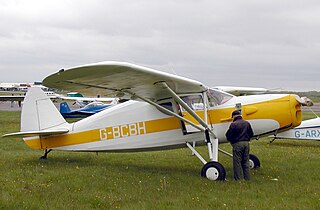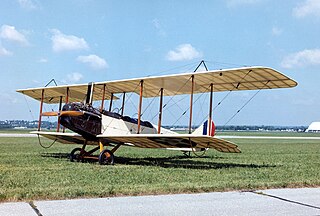
The Curtiss JN "Jenny" was a series of biplanes built by the Glenn Curtiss Aeroplane Company of Hammondsport, New York, later the Curtiss Aeroplane and Motor Company. Although the Curtiss JN series was originally produced as a training aircraft for the US Army, the "Jenny" continued after World War I as a civilian aircraft, as it became the "backbone of American postwar [civil] aviation".

The Vultee BT-13 Valiant is an American World War II-era basic trainer aircraft built by Vultee Aircraft for the United States Army Air Corps, and later US Army Air Forces. A subsequent variant of the BT-13 in USAAC/USAAF service was known as the BT-15 Valiant, while an identical version for the US Navy was known as the SNV and was used to train naval aviators for the US Navy and its sister services, the US Marine Corps and US Coast Guard.

The Beechcraft Model 17 Staggerwing is an American biplane with an atypical negative wing stagger. It first flew in 1932.

The Curtiss Robin, introduced in 1928, was a high-wing monoplane built by the Curtiss-Robertson Airplane Manufacturing Company. The J-1 version was flown by Wrongway Corrigan who crossed the Atlantic after being refused permission.

The Fairchild Model 24, also called the Fairchild Model 24 Argus and UC-61 Forwarder, is a four-seat, single-engine monoplane light transport aircraft designed by the Fairchild Aviation Corporation in the 1930s. It was adopted by the United States Army Air Corps as UC-61 and also by the Royal Air Force. The Model 24 was itself a development of previous Fairchild models and became a successful civil and military utility aircraft.

The Lone Star Flight Museum, located in Houston, Texas, is an aerospace museum that displays more than 24 historically significant aircraft, and many artifacts related to the history of flight. Located at Ellington Airport, the museum is housed on about 100,000 ft2 of property, including its own airport ramp. The museum, formerly located in Galveston, moved to Houston to avoid a repeat of the devastation suffered during Hurricane Ike.

The Aeronca L-3 series of liaison aircraft was used by the United States Army Air Corps in World War II. The L-3 was adapted from Aeronca's pre-war Tandem Trainer and Chief models.

The Hispano Aviación HA-1109 and HA-1112 are licence-built versions of the Messerschmitt Bf 109 G-2 developed in Spain during and after World War II.

The Percival Pembroke is a British high-wing twin-engined light transport aircraft built by the Percival Aircraft Company, later Hunting Percival.

The Aeronca C-2 is an American light monoplane designed by Jean A. Roche and built by Aeronca Aircraft.
The Dakota Territory Air Museum is an aviation museum on North Hill in Minot, North Dakota near Minot International Airport. The mission of the Dakota Territory Air Museum is to be a historical aviation resource honoring the men, women and machines that have impacted the rich history of aviation through displays and events that educate, inspire and entertain people of all ages. The museum consists of a main information room, outdoor displays, a restoration hangar, the Scott Nelson Gallery, the Texas Flying Legends hangar, Wright Flyer Hangar and the Oswin H. Elker Hangar.

The Meyers OTW was a 1930s United States training biplane designed by Allen Meyers and built by his Meyers Aircraft Company from 1936 to 1944.

The Standard J is a two-seat basic trainer two-bay biplane produced in the United States from 1916 to 1918, powered by a four-cylinder inline Hall-Scott A-7a engine. It was constructed from wood with wire bracing and fabric covering. The J-1 was built as a stopgap to supplement the Curtiss JN-4 in production.

The Vintage Flying Museum is a non-profit aviation museum located at Meacham International Airport, Fort Worth, Texas. The primary mission of the museum is to preserve America's flying heritage in word, deed and action. Also located at the museum is Greatest Generation Aircraft, the Invader Squadron of the Commemorative Air Force, the Fort Worth Chapter of the American Rosie the Riveter Association and PGM Aviation.

The Piper Aviation Museum is an aviation museum at the William T. Piper Memorial Airport in Lock Haven, Pennsylvania. It is focused on the history of the Piper Aircraft Corporation.

The Hagerstown Aviation Museum is an aviation museum at the Hagerstown Regional Airport in Hagerstown, Maryland. It is focused on the history of the Fairchild Aircraft Corporation.

















